Formula:
difference = |V1 - V2| / (V1 + V2) / 2 x 100
Percentage Difference Calculator
A Percentage Difference Calculator is a tool used to calculate the percentage difference between two values, helping to quantify the relative difference between them in terms of percentage. This is often used in comparisons where you want to see how much two values differ relative to their average or original values.
What is Percentage Difference?
The percentage difference expresses the difference between two values as a percentage of their average. It is often used when comparing two numbers that represent measurements or values that are not necessarily part of the same data set or category.
The formula for calculating percentage difference is:

Why use a Percentage Difference Calculator?
- Quick Comparison: It allows you to compare two values relative to their average efficiently.
- Simplifies Calculations: Automatically calculates the percentage difference, saving time and reducing errors.
- Useful for Relative Measurements: Provides a more accurate sense of how two values differ relative to their size rather than just using the difference alone.
- Widely Applicable: Commonly used in scientific experiments, data analysis, and daily situations like price comparisons or changes in quantities.
How does a Percentage Difference Calculator work?
- Input:
- The two values that you want to compare.
- Calculation:
- The calculator finds the absolute difference between the two values, divides that by the average of the two values, and then multiplies by 100 to convert it into a percentage.
- Output:
- The percentage difference between the two values (expressed as a percentage).
When should you use a Percentage Difference Calculator?
- In scientific experiments: Comparing measurements or data points to see how much they differ.
- In price comparison: Evaluating the difference between prices or costs of two products.
- In financial analysis: Comparing the performance of different investments or budget variations.
- In quality control: Measuring how much actual production deviates from ideal standards.
- In education or research: Determining differences in test results or performance between two groups.